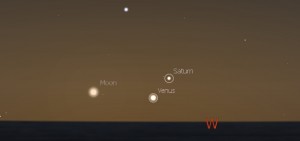These notes are intended to provide a casual sky watcher or someone already into amateur astronomy living on the East Coast of Australia with a short summary of what is happening in the night sky in September 2011. Instructions on how to obtain customised satellite viewing information for your location can be found here. If you find this page of interest, you may wish to follow this website automatically using Twitter and the sites RSS Feed.
Planets this month (September 2011)
Mercury is visible low above the Eastern horizon during morning twilight during the first part of September. It then moves back toward the Sun becoming invisible before reappearing into the evening October sky. Note that due to the angle of the ecliptic at this time of the year, Mercury remains in the morning twilight glow and then is lost in daylight as the Sun rises.
Venus appears in the evening twilight sky this month low on the Western horizon. From an Earthbound observers viewpoint, Venus is slowly moving from behind the Sun (superior conjunction occurred on 16 August).
Mars is visible in the morning sky from around 3 am AEST mid-month. Look above the Eastern horizon.
Jupiter rises around 9 pm AEST mid-month. Look for a brilliant white star low on the Eastern horizon after 9.30 pm. With Venus not being visible in the night sky this month, Jupiter is the brightest object in the night sky beside the Moon.
Saturn is visible but only just. It sets around 7.30 pm AEST mid-month. Look low above the Western horizon before that time to locate it.
Uranus reaches opposition on 26 September. It rises around 6.30pm AEST mid-month. It will require binoculars and a finder chart to locate. You will need at least a small telescope to resolve Uranus as being disc like (as opposed to point-like as a star appears in a small telescope).
With Neptune reaching opposition last month, it is now above the horizon before the evening sky is dark.
Individual sky events (September 2011)
All times listed for the AEST time zone (U.T. plus 10 hours). Add one hour to times listed if your state or territory follows daylight savings time.
September 1: Slim crescent Moon located to the left of Spica (the brightest star in the ancient Greek constellation Virgo the Virgin). Look below the crescent Moon (and to the right) for the brightest star you can see. That is the planet Saturn. Early evening sky.
September 3: Mercury in ascending node
September 3: 4 pm Mercury at greatest Western elongation West (18 degrees)
September 5: 3.39 am First Quarter Moon
September 8: Mercury at perihelion
September 9: Mercury and Regulus close. Regulus is the brightest star in the ancient Greek constellation Leo the Lion. Morning twilight sky. You will need a clear Eastern horizon and a pair of binoculars.
September 10: Comet C/2010 X1 (Elenin) reaches perihelion at a distance of 0.482 astronomical units from the Sun. Further information can be found here: http://www.jpl.nasa.gov/news/news.cfm?release=2011-135
September 12: 7.27 pm Full Moon
September 15: 4 pm Moon at apogee (furthest from the Earth in its orbit at 406,065 kilometres)
September 16: Pluto stationary
September 17: Gibbous Moon located below the planet Jupiter. Jupiter appears as a brilliant white star to the unaided eye. Morning sky.
September 17: 3 am Minor planet (or asteroid) Ceres at opposition. Ceres will reach magnitude 7.6 and will be easily visible in a large pair of binoculars. Ceres is currently located in the constellation Cetus.
September 18: Mercury at greatest latitude South
September 18: Vesta stationary. Don’t forget that Vesta is the easiest minor planet (or asteroid) to locate using a pair of binoculars.
September 20: 11.39 pm Last Quarter Moon
September 23: Crescent Moon located above the planet Mars. Morning sky.
September 23: 7 pm Spring Equinox (or Winter Equinox if you live in the Northern hemisphere). The Sun rises due East and sets due West today.
September 26: 10 am Uranus is at opposition today. This means that Uranus will rise as the Sun sets, and then set as the Sun rises the following morning. Opposition is also generally the time when a planet is at its closest in its orbit to the Earth. This makes it the best time to observe Uranus. Keep in mind my comments about Uranus in the planet section.
September 27: 9.09 pm New Moon
September 28: 11 am Moon at perigee (closest to the Earth in its orbit at 357,557 kilometres)
September 28: A very slim crescent Moon will be located to the left of the planets Venus and Saturn. Evening twilight sky. Very low on the Eastern horizon. Binoculars will be required to attempt to find the Moon.

September 29: 6 am Mercury in superior conjunction with the Sun.
For Further Information
Planet and Moon Rise/Set Times
Planet and Moon rise/set times for 2011 can be found here on this website.
Customised Astronomy & Satellite Viewing information
Information on how to obtain customised astronomy & satellite viewing information for your location can be found here on this website.